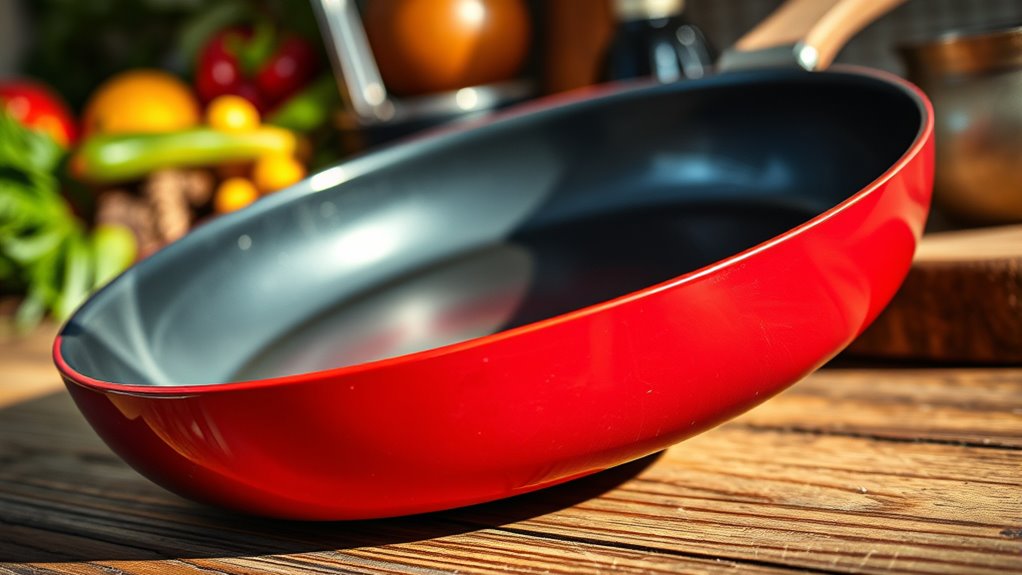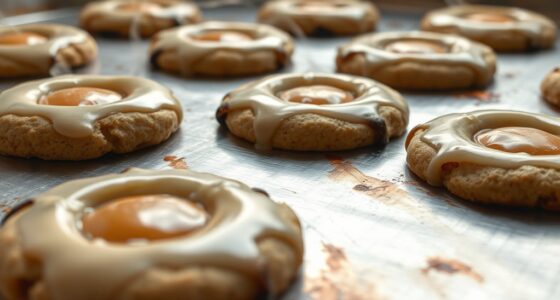Ceramic-coated cookware usually lasts between 3 to 5 years, but its longevity depends on how you care for it. Proper handling—using gentle utensils, avoiding sudden temperature changes, and hand washing—can extend its lifespan. Many people believe ceramic coatings last forever, but everyday use can cause chips or peeling over time. Want to discover more tips and facts that can help you get the most from your cookware? Keep exploring!
Key Takeaways
- Ceramic-coated cookware typically lasts 3-5 years with proper care, but lifespan varies based on usage and maintenance.
- Regular use of metal utensils, high temperatures, and abrasive cleaning can significantly shorten the coating’s durability.
- Proper handling, gentle cleaning, and avoiding thermal shocks extend the cookware’s lifespan and maintain non-stick performance.
- Despite misconceptions, ceramic coatings are not permanent; they will eventually wear, chip, or peel over time.
- Choosing high-quality ceramic coatings and following best practices can maximize cookware longevity and safety.
How Ceramic Coatings Are Made and What They Promise
Ceramic coatings are created through a process that involves applying a liquid solution of silicon-based compounds onto cookware, which is then cured at high temperatures to form a durable, glass-like layer. This process guarantees the coating bonds tightly to the cookware’s surface, creating a smooth, non-porous barrier. The silicon compounds, once cured, form a hard, scratch-resistant surface that’s also non-stick. Ceramic coatings promise several benefits: they’re free of PTFE and PFOA, making them safer for your health, and they withstand high cooking temperatures without breaking down. The glass-like layer provides a slick surface, making food release easier and cleaning simpler. Additionally, the Durability of ceramic coatings is influenced by factors such as proper use and maintenance. Ensuring proper care and handling can significantly extend the lifespan of the coating and preserve its non-stick properties. Proper heat management during cooking also helps prevent damage to the coating, further extending its longevity. Overall, this manufacturing process aims to combine durability, safety, and easy maintenance for everyday cooking.
Expected Lifespan of Ceramic-Coated Pans
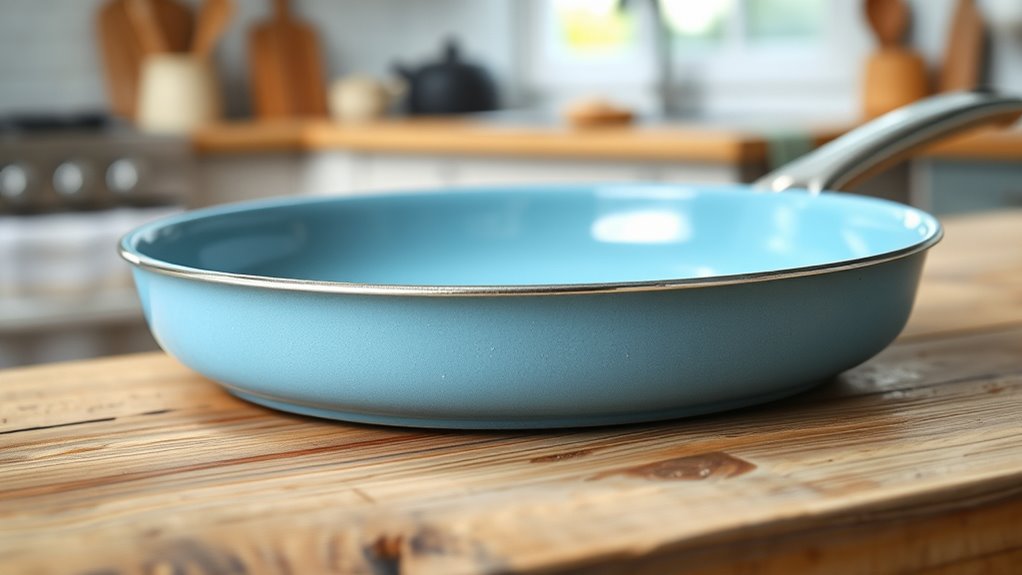
You can expect ceramic-coated pans to last between three to five years with proper care. Several factors, like cooking habits and cleaning methods, influence their longevity. Following maintenance tips helps maximize their lifespan and keeps your cookware performing well. Additionally, avoiding frequent misuse can prevent premature wear and tear, ensuring your pans stay in good condition longer. Proper storage, avoiding metal utensils, and understanding material durability also contribute to maintaining their coating integrity, which is essential for their long-term performance. Regular inspections and gentle cleaning can further help preserve the filtering capabilities, ensuring the cookware continues to provide optimal performance.
Typical Durability Range
The typical lifespan of ceramic-coated pans generally ranges from two to five years, depending on usage and maintenance. Proper care can extend your pan’s durability, but expecting around this timeframe helps set realistic expectations. The table below shows how different factors influence lifespan:
| Usage Frequency | Maintenance Quality | Expected Duration |
|---|---|---|
| Daily | Excellent | 3-5 years |
| Weekly | Good | 2-4 years |
| Occasional | Fair | 2-3 years |
Heavy use and poor maintenance shorten your pan’s life, while gentle handling and proper cleaning can prolong it. Keep in mind, these ranges are estimates—your experience may vary. Regularly inspecting the coating integrity can help identify early signs of wear and prevent damage. Incorporating proper cleaning techniques and avoiding metal utensils can also significantly extend the lifespan of your ceramic-coated cookware. Additionally, understanding product warranties can provide extra assurance and guidance for replacement or repairs. Being aware of manufacturer recommendations can further help in maintaining your cookware’s longevity. Moreover, using non-abrasive cleaning tools can prevent scratches that compromise the coating’s durability.
Factors Affecting Lifespan
Several factors directly influence how long your ceramic-coated pan will last. First, the quality of the coating plays a big role; higher-quality ceramics tend to be more durable. How you use the pan also matters—gentle handling prevents scratches and chips. The heat level you cook at is essential too; high temperatures can weaken the coating over time. Additionally, the types of utensils you use affect longevity—metal tools can scratch the surface, while silicone or wood are gentler. Cleaning habits make a difference as well; abrasive scrubbers or dishwasher use can wear down the coating prematurely. Proper cleaning techniques are vital to maintaining the coating’s integrity. Storage practices, such as stacking with soft padding, help protect the surface from unnecessary damage. Proper heat management is crucial, as excessive or uneven heat can accelerate coating deterioration. Using a quality cookware with a durable ceramic coating can significantly extend the lifespan of your pan. Incorporating proper maintenance practices, such as hand washing and avoiding sudden temperature changes, can further help preserve the coating’s integrity. All these factors combined determine how long your ceramic-coated cookware will stay in good condition.
Proper Maintenance Tips
Proper maintenance is essential to extend the lifespan of your ceramic-coated pans. To keep them in top condition, always use gentle utensils like silicone or wooden tools to prevent scratching the surface. Avoid abrasive cleaners or scouring pads that can damage the coating. When cleaning, hand wash with warm water and mild dish soap; avoid dishwashers, which may weaken the ceramic over time. Make sure to dry the pan thoroughly after washing to prevent water spots and corrosion. Store your pans carefully, stacking with soft cloths or pan protectors to avoid scratches. Regularly check for signs of wear or damage, and replace if the coating starts peeling or deteriorating. Proper care guarantees your ceramic cookware stays non-stick and durable longer. Additionally, materials range from ceramic to recycled products, so understanding the specific coating type can help tailor your maintenance routine for optimal longevity. Being aware of how different coating materials respond to cleaning methods can further enhance your cookware’s lifespan and performance, especially when considering the effects of proper cleaning techniques on the coating’s integrity. For example, using abrasive cleaning tools can accelerate wear and reduce non-stick performance. Regularly inspecting your pans for damage or wear can help catch issues early and extend their usability.
Factors That Shorten the Durability of Ceramic Coatings
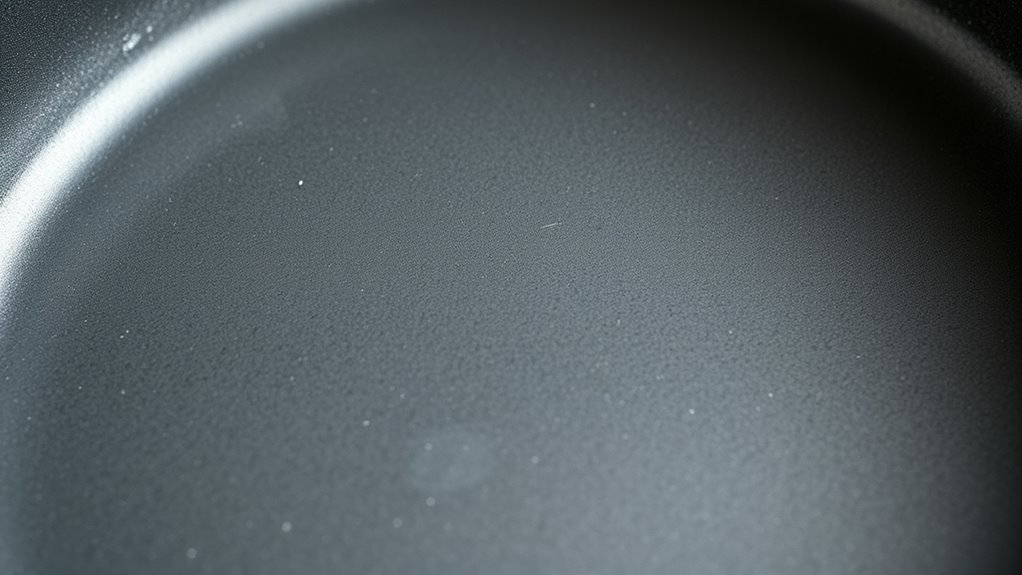
You can easily damage your ceramic coating by using abrasive cleaning tools or harsh scrubbers, which wear down the surface. Cooking at very high temperatures also risks breaking down the coating’s integrity over time. Being mindful of these habits helps extend the life of your cookware. Additionally, using proper cleaning techniques can further preserve the durability of ceramic coatings. Using quality cookware that is designed for longevity can also minimize accidental damage and ensure your ceramic cookware lasts longer. Recognizing the importance of proper care can significantly influence the longevity of your ceramic-coated pots and pans. Incorporating gentle cleaning methods and temperature control aligns with sound sound healing science principles that promote overall health and durability. Choosing appropriate cooking methods can prevent unnecessary strain on the coating and maintain its performance over time.
Abrasive Cleaning Methods
Using abrasive cleaning methods can considerably reduce the lifespan of ceramic-coated cookware. Scrubbing with steel wool, abrasive pads, or harsh scrub brushes damages the delicate ceramic surface, causing scratches and chips. These imperfections create weak spots that lead to peeling and coating deterioration over time. Even using rough sponges or powders like baking soda too aggressively can strip away the protective layer. Instead, opt for soft sponges or cloths and gentle cleaning solutions. Avoid metal utensils and harsh abrasives altogether, as they accelerate wear and tear. Proper care involves gentle cleaning to preserve the ceramic coating’s integrity, ensuring your cookware lasts longer and performs better. Remember, patience and gentle handling are key to maintaining the beauty and durability of your ceramic cookware.
High-Temperature Cooking
Exposing ceramic-coated cookware to high temperatures can markedly shorten its lifespan. When you cook at excessively high heat, the coating can develop chips, cracks, or even delaminate from the base material. High temperatures cause thermal stress, which weakens the ceramic layer over time. This not only reduces non-stick performance but also accelerates wear and tear. To preserve your cookware’s durability, avoid heating it beyond medium or medium-high settings. Always use low to moderate heat for delicate dishes or slow cooking. Additionally, sudden temperature changes—like rinsing a hot pan with cold water—can cause thermal shock, damaging the coating. By controlling your cooking temperature, you considerably extend the life of your ceramic cookware and maintain its non-stick effectiveness longer.
Common Signs That Your Ceramic Pan Is Worn Out
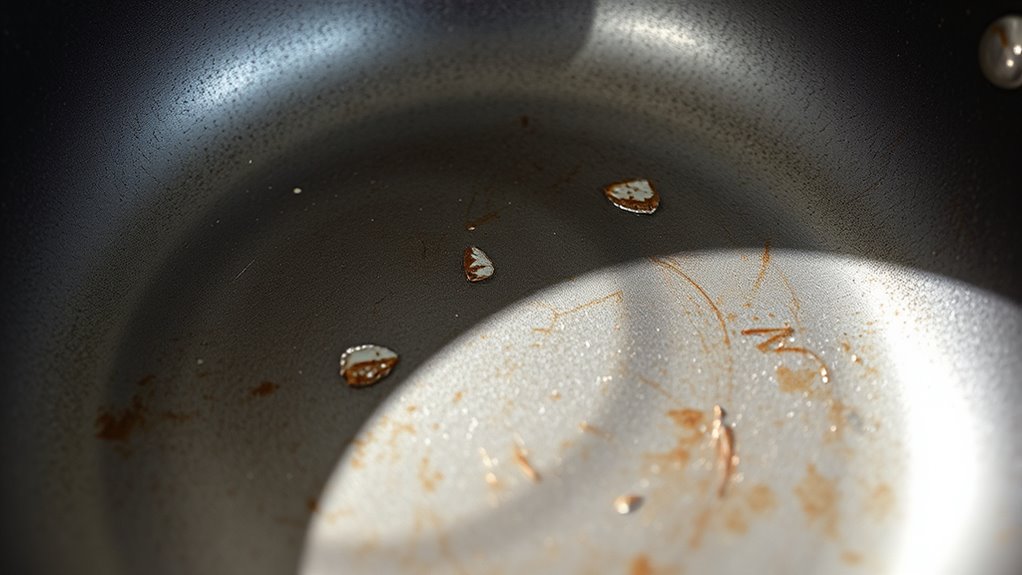
Over time, ceramic-coated pans can show clear signs of wear that indicate it’s time for a replacement. One of the most obvious signs is the appearance of scratches or chips on the surface, which can compromise the non-stick qualities and lead to sticking or uneven cooking. You might also notice the coating starting to discolor or develop a dull, patchy look, signaling that the ceramic layer has degraded. Additionally, if food begins to stick more often despite proper care, it’s likely a sign the coating is no longer effective. Peeling or flaking of the ceramic surface is another strong indicator that your pan has reached the end of its lifespan. When these signs appear, it’s best to contemplate replacing your ceramic pan to ensure safe and efficient cooking.
The Impact of Cooking Habits on Ceramic Coating Longevity

The way you cook can substantially influence how long your ceramic coating stays in good condition. Using high heat frequently can cause the coating to degrade faster, so it’s best to cook on low or medium heat whenever possible. Sharp utensils can scratch the surface, reducing its effectiveness and lifespan, so opt for wooden or silicone tools. Overcrowding the pan or using aggressive stirring can also wear down the coating over time. Additionally, relying heavily on non-stick sprays or cooking with very little oil may lead to buildup or damage. Being mindful of these habits helps preserve your ceramic cookware’s integrity, ensuring it performs well longer. Small adjustments in your cooking routines can make a significant difference in extending the lifespan of your ceramic-coated pan.
Proper Maintenance Tips to Extend the Life of Your Pan
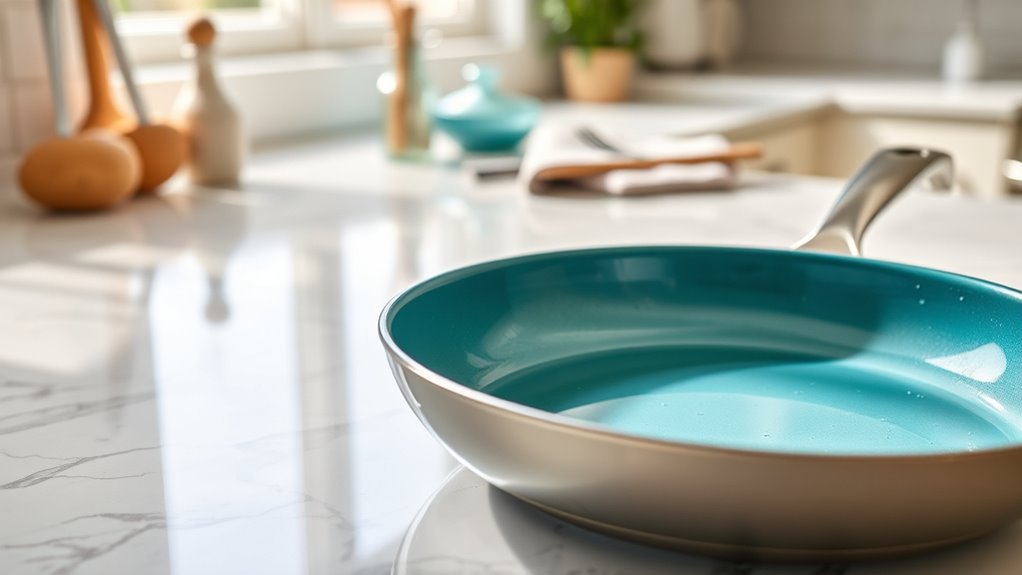
To keep your ceramic-coated pan in top condition, regular proper maintenance is essential. Follow these tips to extend its lifespan:
- Avoid metal utensils that can scratch the surface; opt for silicone, wooden, or plastic tools instead.
- Use mild dish soap and a soft sponge or cloth for cleaning; steer clear of abrasive scrubbers.
- Prevent overheating by cooking on low to medium heat, and avoid preheating an empty pan.
- Store your pan carefully, stacking with a soft cloth or paper towel to prevent scratches.
When to Replace Your Ceramic-Coated Cookware

You should consider replacing your ceramic-coated cookware when you notice signs of wear or persistent sticking that won’t improve. A decline in cooking performance or visible damage can also indicate it’s time for a new pan. Prioritizing safety means replacing your cookware if the coating chips or cracks, preventing potential health concerns.
Signs of Wear
Even if your ceramic-coated cookware still looks decent, signs of wear can appear before obvious damage occurs. Recognizing these signs helps you determine when it’s time to replace your pan. Here are four key indicators:
- Scratched or chipped surface – visible scratches or chips compromise the coating’s integrity.
- Sticking food – if food starts sticking despite proper heating, the coating may be worn out.
- Discoloration or dullness – a faded or discolored surface signals breakdown of the coating.
- Persistent odors or stains – lingering smells or stains that won’t wash out suggest a compromised surface.
Pay attention to these signs, and don’t ignore them. Replacing worn cookware guarantees safe, effective cooking and prolongs your kitchen’s overall hygiene.
Cooking Performance Decline
As signs of wear become more evident, your cookware’s performance often begins to decline. You may notice food sticking more frequently, uneven heating, or the need for higher temperatures to achieve desired results. These issues indicate the ceramic coating’s effectiveness has diminished, affecting cooking efficiency. When these problems persist despite proper care, it’s a sign it’s time to replace your cookware. To better understand the decline stages, consider this table:
| Stage | Indicator | Effect on Cooking |
|---|---|---|
| Early | Slight scratching | Minor food sticking |
| Moderate | Discoloration | Uneven heat distribution |
| Severe | Cracking or peeling | Food sticks heavily, unsafe to use |
| Critical | Loss of non-stick | Difficult to cook effectively |
| End of Life | Visible damage | Complete replacement needed |
Recognizing these signs helps you decide when to retire your ceramic cookware.
Safety Concerns
Cracks, peeling, or other visible damage to your ceramic coating are clear signs it’s time to replace your cookware, as these issues can compromise safety. Damaged ceramic surfaces may release particles or toxins into your food, posing health risks. Here are key warning signs to watch for:
- Cracks or chips exposing the metal core
- Flaking or peeling coating
- Strong, burnt odors during cooking
- Discoloration or uneven surface texture
If you notice any of these, stop using the cookware immediately. Continued use can lead to ingestion of harmful particles or exposure to degraded materials. Prioritize your safety and replace damaged ceramic cookware promptly to ensure safe cooking and maintain peace of mind.
Myths and Realities About Ceramic-Coating Durability
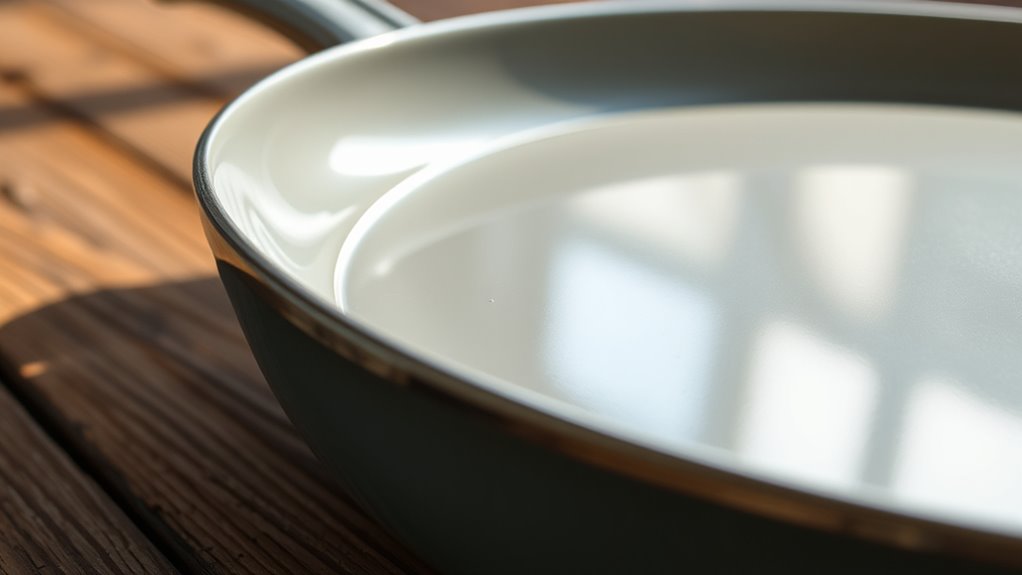
Many consumers believe that ceramic coatings are completely indestructible, but this is a misconception. While ceramic coatings are durable, they aren’t immune to damage. Scratches from metal utensils, abrasive cleaners, or sudden temperature changes can weaken the surface over time. Some think that because ceramic is non-stick, it will last forever, but everyday use wears down the coating gradually. The myth that ceramic coatings won’t chip or peel is also false; with improper care, chips can develop. In reality, ceramic coatings excel when properly cared for, such as avoiding metal utensils and using gentle cleaning methods. Understanding these realities helps you extend the lifespan of your cookware, ensuring you get the most value and performance from your investment.
Comparing Ceramic-Coated Pans With Other Non-Stick Options
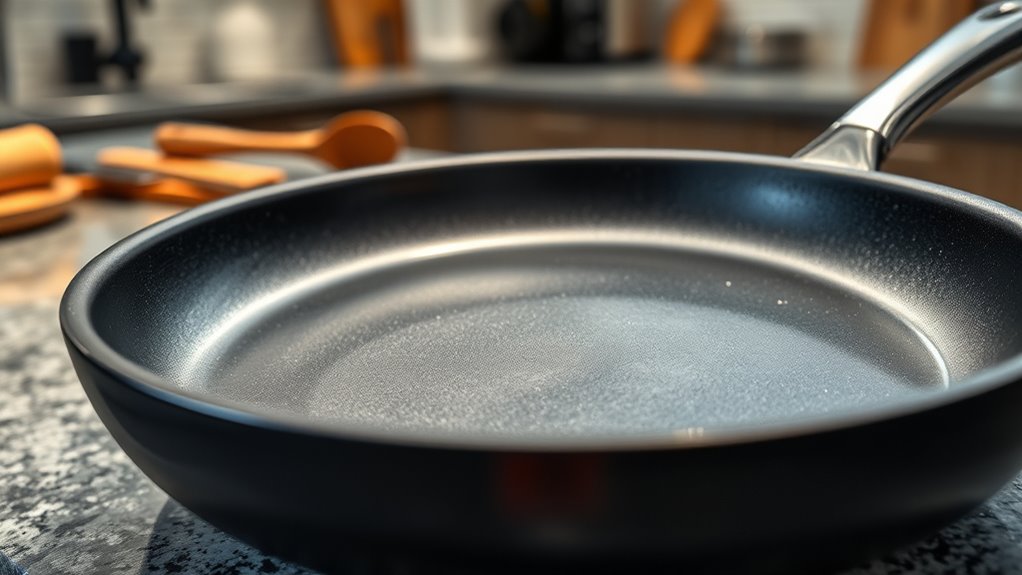
When choosing non-stick cookware, ceramic-coated pans often stand out due to their natural, chemical-free surface and appealing appearance. You might consider how they compare to other options like Teflon, cast iron, stainless steel, or silicone. Here are key differences:
- Teflon (PTFE): Offers excellent non-stick performance but can degrade at high temperatures and release fumes if overheated.
- Cast Iron: Highly durable and naturally non-stick when seasoned, but heavier and requires maintenance.
- Stainless Steel: Not inherently non-stick, but with proper technique, can produce similar results; more versatile but less forgiving.
- Silicone: Ideal for baking and heat-resistant molds, but not suitable for stovetop frying.
Ceramic-coated pans provide a safer, eco-friendly alternative with decent non-stick properties, but may need more care than some other options.
Choosing the Right Ceramic Cookware for Long-Term Use

Choosing the right ceramic cookware for long-term use involves considering factors like durability, safety, and ease of maintenance. Look for options with thick, high-quality ceramic coatings that resist scratches and peeling. Check for cookware made from sturdy materials like stainless steel or aluminum with reinforced ceramic layers. Make certain the handles are heat-resistant and securely attached for safe handling. Safety is vital, so verify that the cookware is free from toxic chemicals like PTFE or PFOA. Ease of cleaning also matters—choose pieces that are dishwasher safe or simple to hand wash without harsh scrubbing. Reading reviews and product warranties can help gauge longevity. By prioritizing these factors, you’ll select ceramic cookware that stands the test of time and supports healthy cooking habits.
Frequently Asked Questions
Can Ceramic Coatings Be Repaired if Scratched?
When your ceramic-coated cookware gets scratched, you might wonder if it can be fixed. Unfortunately, scratches usually can’t be repaired or restored to their original state. While some products claim to fill in scratches, they often don’t provide a permanent solution. To keep your cookware in top shape, avoid metal utensils and gentle cleaning. If scratches are severe, consider replacing the piece to ensure safe and effective cooking.
Do Different Brands Offer Varying Ceramic Coating Lifespans?
Did you know that some brands offer ceramic coatings that last up to five years, while others only last a year or two? You’ll notice big differences in lifespan depending on the brand you choose. It’s important to research and read reviews because quality varies widely. By selecting a reputable brand, you can enjoy longer-lasting cookware and get better value for your money, ultimately making cooking more enjoyable and less frustrating.
Is Dishwasher Cleaning Harmful to Ceramic-Coated Pans?
You might wonder if dishwasher cleaning harms your ceramic-coated pans. Generally, most ceramic coatings are durable enough to handle dishwasher cycles, but frequent or harsh cleaning can wear down the coating over time. To keep your pans in top shape, it’s best to hand wash them with gentle detergents. Using the dishwasher sparingly and avoiding abrasive scrubbers helps preserve the coating’s longevity and prevents damage.
How Do Temperature Fluctuations Affect Ceramic Coating Longevity?
Temperature fluctuations can considerably impact your ceramic-coated cookware. When you expose your pans to sudden hot-to-cold changes, the coating may crack or peel over time. To keep your cookware in good shape, avoid drastic temperature shifts and let it cool gradually before washing. This way, you help preserve the ceramic coating’s integrity, ensuring it lasts longer and performs better during your cooking adventures.
Are Ceramic Coatings Safer Than Traditional Non-Stick Surfaces?
You might wonder if ceramic coatings are safer than traditional non-stick surfaces. Generally, ceramic is considered safer because it’s made from natural materials and doesn’t contain chemicals like PTFE or PFOA, which can release harmful fumes when overheated. You can cook confidently knowing ceramic-coated cookware is a healthier choice, especially when used properly at medium temperatures. Just avoid overheating to maintain safety and extend the cookware’s lifespan.
Conclusion
Did you know that properly cared-for ceramic-coated pans can last up to five years? By understanding how they’re made and avoiding common mistakes, you can greatly extend their lifespan. Remember, frequent use and harsh cleaning can shorten their life, but with gentle handling, you’ll get the most out of your cookware. Stay mindful of signs it’s time to replace, and you’ll enjoy its non-stick benefits longer, saving you money and hassle in the kitchen.
